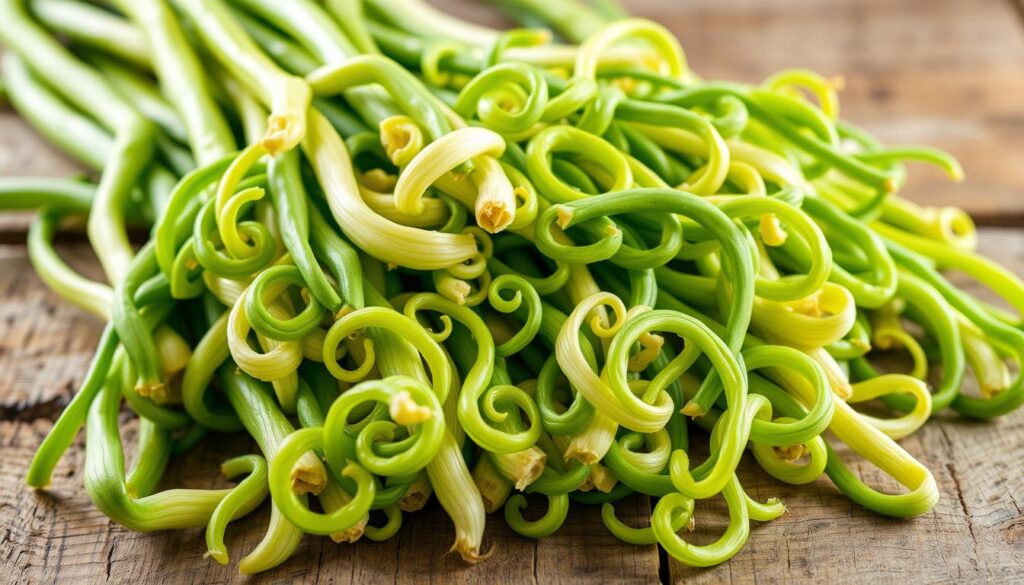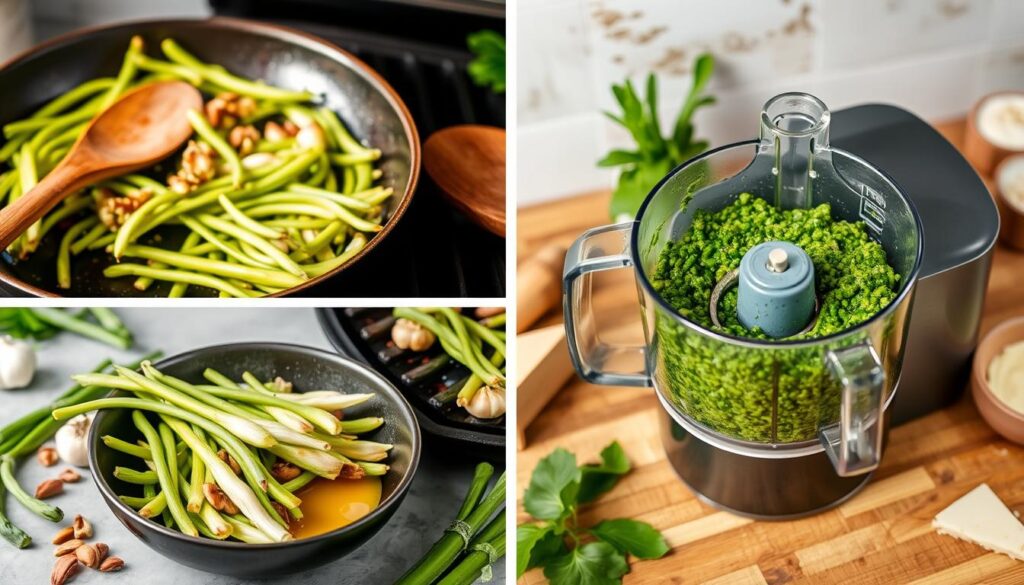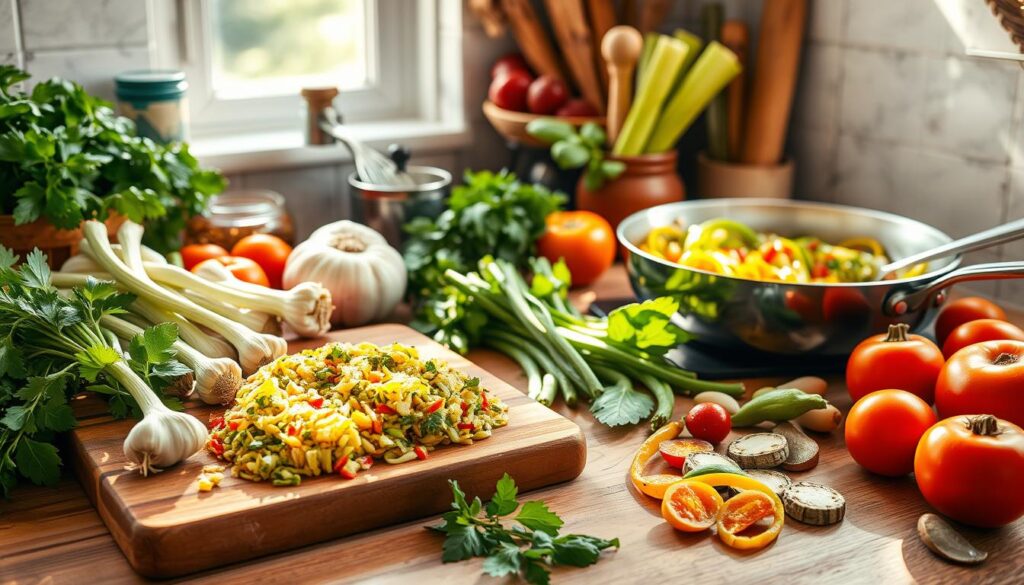Garlic scapes season is eagerly awaited by gardeners and food lovers. It happens in early summer, when garlic scapes are ready. These scapes have a unique taste and crunchy texture.
They are a rare treat, cherished by chefs and home cooks. Everyone looks forward to using them in their recipes.
As garlic scapes become more popular, knowing when to harvest them is key. They are packed with nutrients and can be used in many dishes. This makes them a favorite in kitchens everywhere.
Table of Contents
What Are Garlic Scapes and Their Culinary Uses?
Garlic scapes are the flower stalks of hardneck garlic plants, from the allium sativum species. They’ve been used in cooking for centuries, mainly in Asian and Mediterranean dishes. They taste mild and slightly sweet, with a crunchy texture.
Definition and Origin of Garlic Scapes
Garlic scapes belong to the allium family, which includes onions, chives, and leeks. They grow naturally from garlic plants. In mid-summer, they are often cut off to help the bulbs grow bigger.
Common Culinary Applications
Garlic scapes are great in many dishes, such as:
- Stir-fries and sautés
- Salads and soups
- Pesto and other sauces
- Grilled or roasted as a side dish
They can also be pickled or used as a scallion or ramp substitute in recipes.
Nutritional Benefits
Garlic scapes are packed with vitamins and minerals. They have antioxidants and other good stuff. Plus, they’re low in calories and high in fiber, making them a healthy addition to meals.
When Does Garlic Scapes Season Occur?
Garlic scapes season usually happens in early summer, from May to July. The exact time can change based on where you are and the weather. To know when to harvest garlic scapes, watch your plants closely. Look for scapes that are 10 to 12 inches long and have a curly shape.
The garlic scapes season depends on temperature, moisture, and sunlight. These things help the scapes grow. It’s important to pick garlic scapes when they’re ready. This is when they start to curl into a spiral shape.
When deciding the best time to pick garlic scapes, consider a few things:
- Region and climate
- Weather conditions
- Plant variety
- Scape development and shape
By watching these factors and checking your plants often, gardeners can get the most from thegarlic scapes season. They can enjoy a lot of scapes and bulbs, including thescape flowerat the tip of the scape.
How to Select the Best Garlic Scapes
Choosing the right garlic scapes is key. They’re ready to pick about a month before the garlic bulbs. Look for scapes that are fresh, tender, and bright green. Trimming them helps the plant grow bigger bulbs.
Scapes should be 10 to 12 inches long. They should feel tender but firm. For the best scapes, grow hardneck garlic. Knowing when to cut them is also important. Cut before the flower blooms to keep energy in the bulb.
Here are some key characteristics of high-quality garlic scapes:
- Fresh, tender, and vibrant green color
- Ideal size: 10-12 inches long
- Tender and slightly firm texture

By focusing on these traits, gardeners can get a great harvest. Whether for cooking or plant health, picking the right scapes is vital.
Preparing Garlic Scapes for Cooking
Garlic scapes are tasty and easy to prepare for cooking. First, you need to know what does a garlic scape look like. They are the curly, green shoots from garlic bulbs. You can pick them in late spring to early summer.
To cook, you must remove garlic scapes from the bulb. Then, clean and trim them. Rinse the scapes under cold water and dry with a paper towel. Remove the garlic scapes flowers and trim off any tough parts.
After preparing, you can cook garlic scapes in many ways. You can sauté, grill, or roast them. Here are some tips for cooking garlic scapes:
- Sautéing: Heat oil in a pan and add the garlic scapes. Cook for 3-5 minutes, until tender and lightly browned.
- Grilling: Brush with oil and season with salt and pepper. Grill over medium heat for 2-3 minutes per side, until tender and lightly charred.
- Roasting: Toss with oil, salt, and pepper. Roast in the oven at 400°F (200°C) for 10-15 minutes, until tender and lightly browned.

Delicious Recipes Featuring Garlic Scapes
Gardeners and food lovers can enjoy garlic scapes in many dishes. From garlic scapes pesto to grilled garlic scapes, they’re versatile. Websites like food52 have lots of creative ideas.
Garlic scapes are great in pesto with pine nuts and parmesan. Or, grill them with lemon for a tasty side. They’re also good in soups, salads, and on pizzas. Their mild, sweet flavor makes them a great addition to many dishes. For more ideas, check out housegardenia.
Here are some key facts about garlic scapes:
- Garlic scapes can be refrigerated for up to 3 weeks
- A typical serving size of garlic scape pesto yields 6-8 servings
- Garlic scapes can be substituted for basil in pesto recipes

Garlic scapes add a unique flavor to your cooking. Whether you’re making garlic scape pesto, grilled garlic scapes, or something else, they’re sure to impress.
Storage Tips for Garlic Scapes
Garlic scapes can stay fresh in the fridge for up to two months. Place them in BPA-free or reusable silicone bags without sealing. To keep them fresh, store them in an air-tight container with a damp paper towel. This can make them last two to six weeks.
Freezing garlic scapes is another good option. Just chop them into small pieces and put them in a freezer-safe bag or container. Using silicone molds for freezing is helpful for portion control. This way, you can enjoy their flavor and texture in stir fries and more.
Here are some more tips for storing garlic scapes:
- Store them in a mason jar with daily water changes for a few days at room temperature.
- Dehydrating garlic scapes at 135°F for 24 hours is another method for long-term storage.
- They can also be stored in the fridge for two months in BPA-free or reusable silicone bags without sealing.
By using these storage tips, you can enjoy garlic scapes all year. Whether you store them in the fridge or freezer, keeping them fresh is key.
| Storage Method | Duration |
|---|---|
| Refrigerator | Up to 2 months |
| Freezer | Up to 6 months |
| Dehydrator | Up to 1 year |
Health Benefits of Incorporating Garlic Scapes
Garlic scapes are packed with nutrients, providing garlic scapes health benefits like antioxidants and heart health. They are full of antioxidants, which fight cell damage. This can lower the risk of diseases like heart disease and cancer.
The garlic scapes nutrition facts are impressive. They are a good source of protein, vitamin C, and calcium. Garlic scapes may prevent heart disease, high blood pressure, and reduce inflammation. They contain compounds like allicin and allium, which might slow bone breakdown and lower osteoporosis risk.
Some of the key health benefits of garlic scapes include:
- Rich in antioxidants, which can help protect against oxidative damage
- May help prevent heart disease and high blood pressure
- Can reduce inflammation and improve overall health
- Contain active compounds that may reduce the risk of osteoporosis
As noted on gardening websites, garlic scapes can be stored in the fridge for up to 3 weeks. This allows you to enjoy their health benefits for longer. With their mild taste and many health perks, garlic scapes are a fantastic addition to a healthy diet.
Sustainable Garlic Scapes Harvesting Practices
Harvesting garlic scapes needs to be done in a way that’s good for the environment and the plants. Garlic scapes harvesting can help local food systems and cut down on food production’s carbon footprint.
When foraging, it’s important to only take what you need. This way, you avoid harming the plant or the environment. It also makes sure the scapes are picked at the best time, giving them the best taste and texture.
Here are some tips for sustainable garlic scapes harvesting:
- Harvest garlic scapes in the morning, when the dew is there, to keep the plant hydrated and healthy.
- Use sharp tools to cut the scapes, which helps the plant grow better.
- Leave some scapes to grow, so the plant can make seeds for next year’s harvest.
By following these ethical foraging tips and supporting local farmers, you can enjoy sustainable garlic scapes. This helps the environment and ensures the plants are cared for properly.
| Hardiness Zone | Garlic Scapes Harvest Time |
|---|---|
| Zones 3-4 | Late June |
| Zones 5-6 | Mid June |
| Zones 7-8 | Early June |
| Zones 9+ | Late May |
Creative Uses Beyond the Kitchen
Garlic scapes are more than just a kitchen ingredient. They can be used to make infused oils. These oils have a rich, garlicky taste that’s great in cooking or as a natural remedy. Just simmer garlic scapes in good olive oil or neutral oil to infuse the flavors.
Garlic Scape Infused Oils
Garlic scape infused oils are a must-have in any kitchen. The scapes’ pungent, sweet aroma blends well with the oil. This makes a versatile condiment perfect for sautéing veggies, dressing roasted meats, or dipping bread.
These oils also have skincare benefits. The compounds in garlic scapes might help fight off microbes and reduce inflammation when applied to the skin.
Home Gardening Tips for Growing Garlic Scapes
Garlic scapes are easy to grow at home. Plant garlic cloves in soil that drains well and is rich in nutrients. Make sure they get plenty of sunlight.
As garlic plants grow, scapes will curl out from the center. Cut them when they’re 6-12 inches long. This way, you won’t harm the plant. With the right care, one garlic plant can give you many harvests of scapes.
Frequently Asked Questions
What month should you cut garlic scapes?
Garlic scapes usually show up in late spring to early summer, depending on your location. In most areas of the U.S., this means June. The exact timing depends on your garlic variety and climate, but a good rule of thumb is to start checking about a month before your garlic bulbs are ready to harvest. Once the scapes start curling into loops, it’s time to snip them off.
What part of garlic scapes do you eat?
The entire tender, curly green stalk is edible! Most people eat the top portion, including the loop and the stem leading up to the point where it starts to toughen. The flower bud at the tip is also edible, but some prefer to remove it for a softer texture. You can use garlic scapes raw in salads, blend them into pesto, or sauté them for a mild garlic flavor.
What do garlic scapes look like when ready to harvest?
When garlic scapes are ready to cut, they will be long, green, and curled into one or more loops. If they are still sticking straight up, they need more time. Once they form full curls, it’s the perfect time to harvest—if you wait too long, they will become woody and tough.
What part of garlic scapes do you cut off?
You want to cut off the entire scape from the point where it emerges from the plant. Use scissors or garden shears to snip it just above the leaves. This helps direct more energy into growing a bigger garlic bulb. If you’re using the scape for cooking, trim off any woody ends before eating.
What happens if you don’t cut garlic scapes?
If you leave garlic scapes on the plant, the plant will put energy into flowering instead of growing a bigger bulb. This can lead to smaller garlic heads at harvest time. The scape will eventually straighten out and develop a flower, which produces tiny garlic bulbils. While these bulbils can be planted, they take years to develop into full-sized garlic.
How many garlic scapes equal a clove?
Garlic scapes have a milder flavor than garlic cloves, so the conversion depends on how strong you want the garlic taste to be. A general guideline is that one scape (about 10 inches long) is roughly equivalent to one clove of garlic. If you love a strong garlic punch, you might want to use more!

